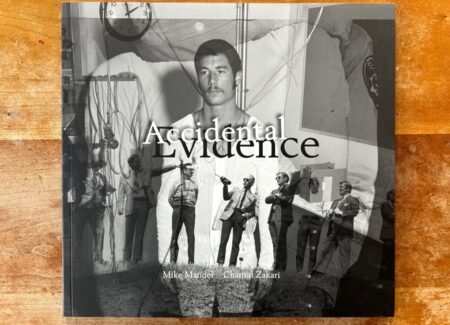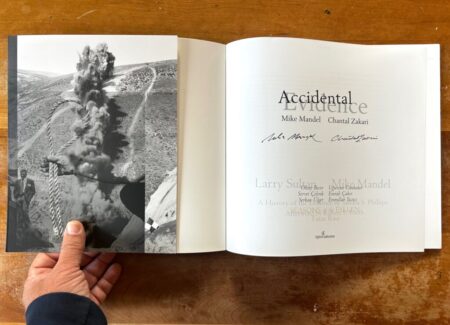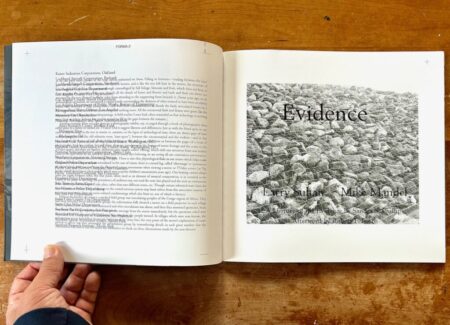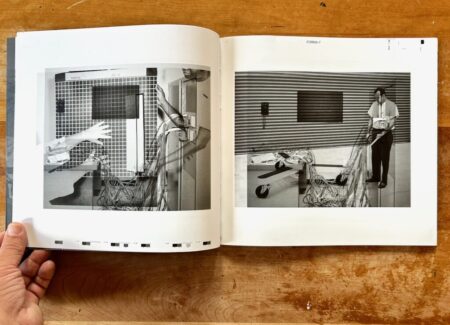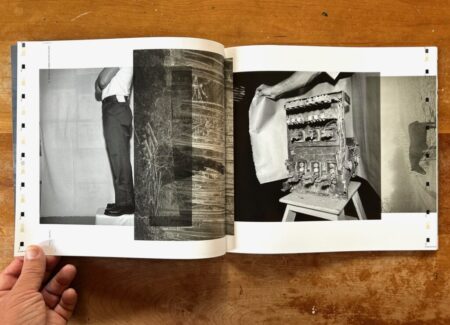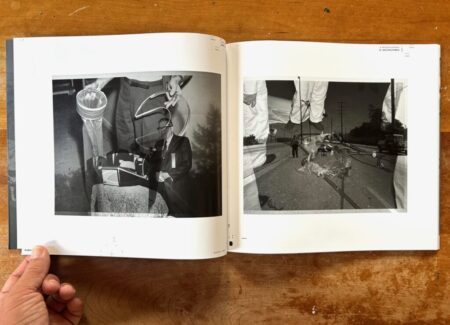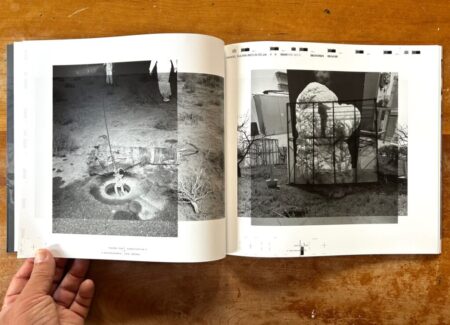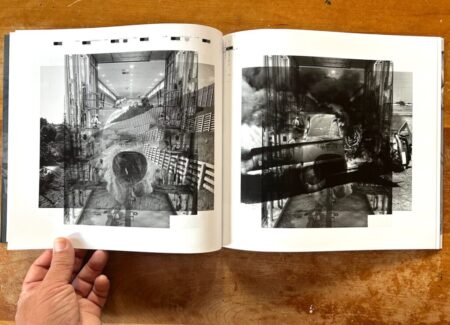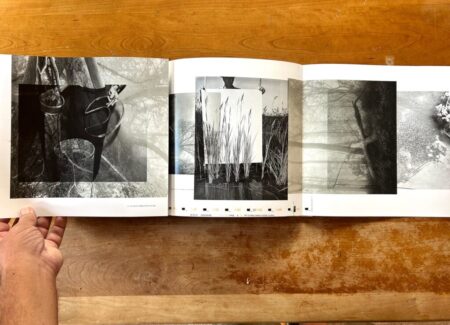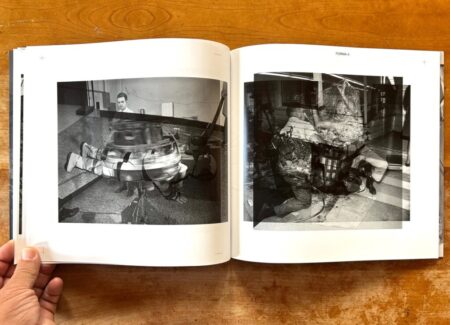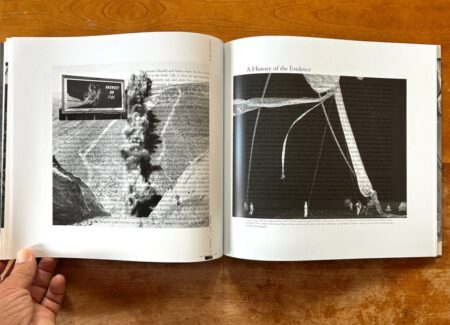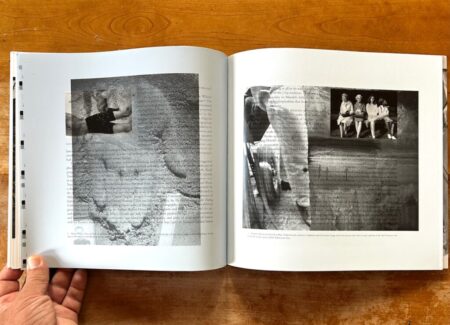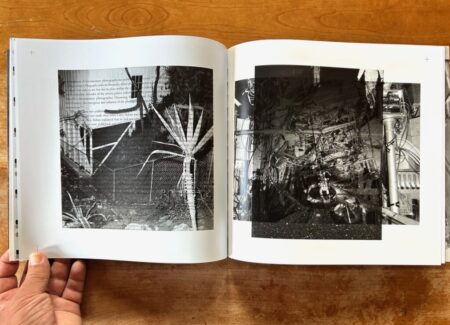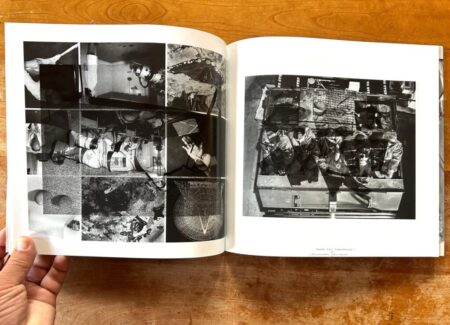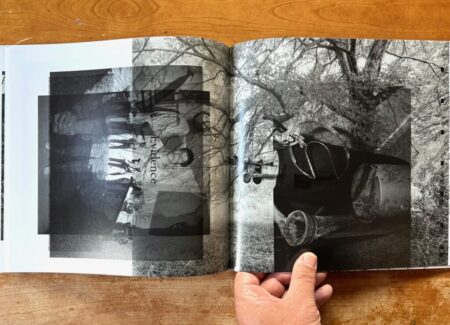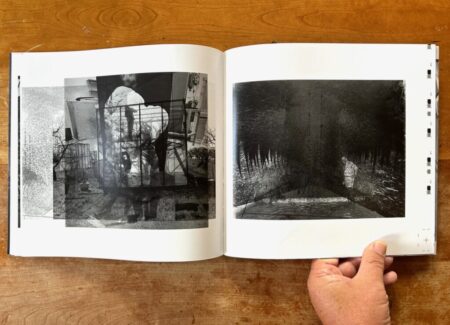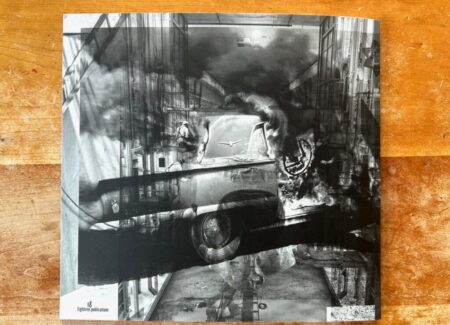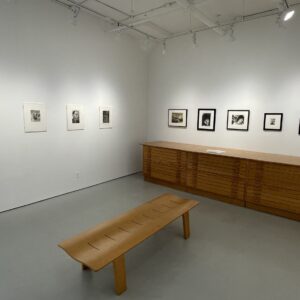JTF (just the facts): Published in 2025 by Eighteen Publications (here). Softcover with end flaps, 10 x 10.5 inches, 52 pages, with numerous images stacked as multiple exposures. Includes four page gatefold. (Cover and spread shots below.)
Comments/Context: Few photobooks are as revered or influential as Larry Sultan and Mike Mandel’s Evidence. “One of the most beautiful, dense and puzzling photobooks in existence”, crowed Martin Parr breathlessly in The Photobook: A History. “An endless visual box of tricks.” High praise from an aficionado.
Since its publication in 1977, Evidence has reverberated across a generation of successors. Image appropriation and recontextualization are now de riguer, so engrained that it might be hard to remember just how radical they were in the seventies. But photography of that era still largely followed an auteur model, with unassailable artistes carving out territory through craft, diligence, and inspiration. Evidence put the quash on that approach in one fell swoop. Why spend hours toiling afield when fantastic photos—indeed an entire project—could be procured from anonymous bureaucratic records? In this brave new world, camera toting technicians might be unwitting visual savants. Sober curation might have more impact than creative genius. Who knew?
If you are a Collector Daily reader, chances are you did. You probably own a copy of Evidence and you’ve formed your own opinions. No need to rehash its contents here. For the sake of this review, the salient point is that this was a landmark book with staying power. The original has merited four reprints over the past quarter century, although it took a while to get the ball rolling. When I first learned about Evidence in the mid-1990s, it was only through rumor and innuendo. The book had fallen out of print and was nearly impossible to find. I could only imagine what any of its photos might look like. The 2003 second edition finally quenched my curiosity, and Evidence gradually became one of my favorite photobooks. Three subsequent editions followed. The most recent of these has now spawned a spinoff, Accidental Evidence.
As the title infers, Accidental Evidence came about by accident. In 2024 the married duo of Mike Mandel and Chantal Zakari traveled to Ofset Yapimevi in Istanbul for the fifth printing of Evidence. With new scans and improved files, this promised to be the best one yet. But it required some drudgery. As they describe the book publishing process, “the experience of being on press is a restless combination of waiting and working.” Test prints were made, checked, corrected, and confirmed before a slightly revised cycle repeated over the course of hours and days.
During one period of downtime, Zakari noticed a pile of “make-ready sheets” lying on a pallet in the corner of the facility. These are scrap pages used by an offset printer to calibrate ink levels and alignment on the path to final production. They are normally reused and reprinted with multiple layers of images until eventually blackened and discarded. In this case, images from Evidence had been printed atop other random images from elsewhere in the book. They had also been combined with photographs from an unrelated book printed at Ofset Yapimevi a few days earlier, Seasons of The Fallen by Faraz Ravi.
As the original Evidence demonstrated, one person’s trash is another one’s treasure. Whereas most people might have dismissed the heap of rejects out of hand, Mandel and Zakari sensed an opportunity. They found the multilayered make-readys unpredictable and alluring. Their serendipity and accidental beauty recalled the unintentional revelations of Evidence itself. You might say the images combined like a married couple, with disparate ideas and impulses cross-pollinating in mutual support, ignited by a spark of chaos.
The pair began to collect favorite make-readys into a pile for their themselves, which they later took home for further exploration. For Mandel, their layerings had a deeper resonance. Long ago he and Larry Sultan had conceived a similar project repurposing make-ready sheets discarded by Mike Roberts Color Productions in California, where they’d once printed postcards. That project had never gotten off the ground, and Sultan had passed away in 2009. But the idea was still simmering, if barely.
Accidental Evidence breathes fresh life into Mandel’s old concept with a dense flurry of make-readys, all scavenged from the cutting room floor at Ofset Yapimevi. Image size, print fidelity, and sequencing pay direct homage to Evidence. But there are some new tweaks. Accidental Evidence is slightly larger and thinner than its predecessor, with a softbound cover, pull-out gatefold, and color swatches and crop marks lining the margins. But all of these changes are minor compared to the titular twist: the purpose of the originals has been jumbled into accidents.
Fans of Evidence will likely find the browsing experience disjointed. There are many familiar photos lurking within, but they are initially hard to recognize. All have been filtered through a Twilight Zone lens. For example, the team of hard-hatted scientists we remember walking into a surreal cloudscape is now blended with the photo of textured leather glove holding a skinny monkey. The photo of Santa Cruz police head-locking a figure from behind has been alternately mixed with suited men overlooking a vista, the hyper-wired man in pajamas, and hardscaped curving berms. In another image, those same berms blur with the burning car photo. And so on. This is a photographic version of speed dating with the brakes on.
In some cases, text passages are layered with other visuals. Partial excerpts come through loud and clear—“Filling in between, ‘reading between the lines’” suggests one—while other passages are entirely lost in translation. It’s only slight consolation that the texts appear roughly in the same position as the originals. The opening page of Accidental Evidence lists archival sources, just as in Evidence. And “A History of the Evidence” by Sandra S. Phillips finds its proper place at the end, on the same light blue page stock as in the 2003 edition. Fine in theory. But in this version, both sections are largely illegible and inoperable as critical context. The words been stripped of meaning, rendered instead as blunt evidence.
Mandel and Zakari explore this vein with purpose on the title page, which boasts new texts layered against the original title page from Evidence. The alignment and clarity of the wording give away the game: this is not an accidental make-ready, but an intentional synthesis. They authors send a warm shout out to Faraz Ravi and the print team at Ofset Yapimevi, each credited by name as an unwitting contributor.
The original 59 photographs of Evidence were beguiling enough when we first encountered them as singles—in fact that was their primary charm. Accidental Evidence elevates them now into truly absurdist territory. For some, the clutter will likely be overwhelming. But for this viewer at least, the effect is every bit as charming. The images mentioned above are merely the easiest to unpack, comprised of simple dual layerings. Others are more tangled, with 3 or more images stacked together. Throw an unrelated project into the mix out of left field—sepia landscapes from Seasons of The Fallen—and many resist any decoding. The chaos reaches a crescendo of sorts in the interior gatefold. This is a four panel spread with multiple layers stitched into a single panoramic collage. As an art piece, it’s a tour de force. But good luck dissecting its parts.
The sly subtext to Accidental Evidence is that it mimics the serendipitous process which Sultan and Mandel used to create Evidence. The process of combining images in random fashion is not unlike a scientific experiment. Images blend in unpredictable ways. Further testing yields new results, and new ideas. When these processes were photographed in the seventies, the documents wound up a government archive. The genius of Evidence was its ability to carve through those raw mine tailings and identify the visual nuggets. “By definition these found objects are records and by implication they are cultural artifacts,” explained Sultan and Mandel in their original press release. “This is a … poetic exploration upon the restructuring of imagery.” That description is from 1977, but it applies surprisingly well to the current book. Accidental Evidence also salvages beauty from random happenstance, a “restructuring of imagery”.
Other photographers have attempted something similar, exploring the incidental wonders of multiple exposures, Boris Mikhailov (reviewed here) and Robert Heinecken (reviewed here) are among the more memorable. James White followed them with a tangential approach, painting grey strokes directly onto the surface of photos from Evidence for his monograph of the same title (published by MACK in 2021).
Accidental Evidence occupies a space somewhere between these efforts and Evidence itself. As a collection of pure images, it’s quite entertaining. The layerings are deep, the permutations tantalizing, and the reader is never bored. That said, these bits of accidental evidence have a whiff of removal. It’s hard to parse much meaning or concrete information from anything past the title page. Perhaps that’s not surprising. These are pictures occluding pictures, after all. Stack enough ink atop other ink and the Rorschach eventually becomes impenetrable.
Collector’s POV: Aside from first edition copies of Evidence, Mandel’s work has only been available infrequently in the secondary markets in the last decade. With no current gallery representation available, connection with the artists via their website likely remains the best option for those collectors interested in following up.
